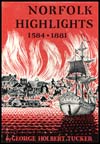Chapter 27
Norfolk's Presbyterian Beginnings
Although the Anglican Church was the only officially recognized religion in Virginia until its disestablishment by an act of the Virginia Assembly in December of 1776, it is a matter of record that there were Presbyterians in the Norfolk area as early as the second half of the Seventeenth Century. Because of restrictions placed on dissenters by the civil authorities, however, Norfolk area Presbyterians had no regular churches, and what meetings that were held took place in private homes and with the grudging approval of the county court.
Pre-Revolutionary Norfolk Presbyterian history, despite the large number of prosperous Scots who lived in the borough, is not too well documented. But it is known that the Reverend Francis Makemie (c.1658-1708), regarded as the chief founder of the Presbyterian church in America, administered to the Presbyterians on "Elizabeth River in Virginia" off and on from 1684 to 1692.
Upon his arrival in the Norfolk area, he wrote: "I found there a poor, desolate people mourning the loss of their dissenting minister from Ireland whom the Lord had pleased to remove by death the previous summer."
Makemie, who was later described by Lord Cornbury, the royal governor of New York, as a "Jack of all Trades; he is a Preacher, a Doctor, a Merchant, an Attorney or Counsellor at Law, and what is worse of all, a Disturber of Governments," was succeeded in the Norfolk area by the Reverend Josias Mackie, an Anglican clergyman with Presbyterian leanings, who died in 1716. From then on, Norfolk Presbyterian history is vague until after the enactment of Thomas Jefferson's "Statute for Religious Freedom" by the Virginia General Assembly of 1784-85.
Free at last to establish a church of their own, a group of twenty-five Norfolk Presbyterians, most of them of Scottish birth, met on April 25, 1800, in the Norfolk Borough Court House and made plans to build a church on property bought for that purpose on the northwest corner of Charlotte and Catharine, (later Bank) streets. A subscription was opened at one hundred dollars a share to provide funds to build the church. Of the eighty-seven subscribers, the majority were of Scottish origin, but the enterprise was so popular that Moses Myers, one of Norfolk's merchant princes and a Sephardic Jew, was one of the shareholders.
As early as 1793, the Reverend Benjamin Porter Grigsby, who was to be the church's first minister, had been sent by the Presbyterian General Assembly in Philadelphia "to itinerate through the lower parts of Virginia" to administer to Presbyterians living there. Grigsby was so popular in Norfolk that he was invited to be the first minister of the new church, which was completed early in 1802, a few months after he had become its minister in 1801. Built of brick, the church was topped by a small, graceful cupola in which hung Norfolk's first known church bell, which gave the edifice its nickname "The Bell Church."
Grigsby married Elizabeth McPherson, a wealthy Norfolk girl, on January 2, 1806. Commenting on the marriage a sharp-tongued English lady then living in Norfolk wrote:
"He provident as pastors are,
Soon turned his eyes among the fair;
And singled out a girl with land,
Negroes and money, at command;
(Thus striving hard, a case most common,
To serve at once both God and mammon.)"
Be that as it may, the union produced Hugh Blair Grigsby (1806-1881), the celebrated Norfolk-born Virginia historian.
Four years later, the Reverend Mr. Grigsby was summoned one Sunday afternoon to conduct the funeral of a sailor who had died of yellow fever, and one week later he died of the same disease. He is buried in Trinity Churchyard in Portsmouth.
It is from "The Bell Church" that all of the Presbyterian churches in Norfolk descend.
Chapter
28
Flags of Fortune
Norfolk Highlights 1584 - 1881

See the "Table of Contents" for links to every chapter in Norfolk Highlights 1584 - 1881 by George Holbert Tucker.
